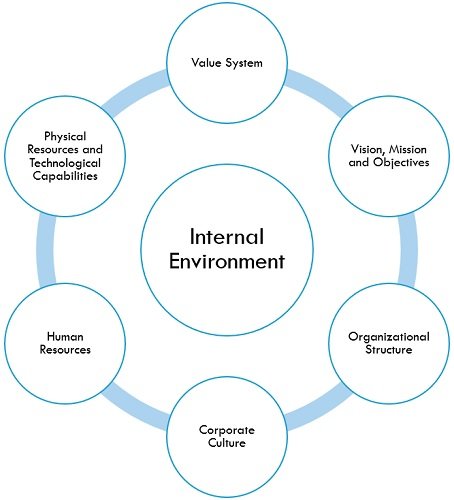Internal environment is a component of the business environment, which is composed of various elements present inside the organization that can affect or can be affected with, the choices, activities and decisions of the organization.
It encompasses the climate, culture, machines/equipment, work and work processes, members, management and management practices.
In other words, the internal environment refers to the culture, members, events and factors within an organization that has the ability to influence the decisions of the organization, especially the behaviour of its human resource. Here, members refer to all those people which are directly or indirectly related to the organization such as owner, shareholders, managing director, board of directors, employees, and so forth.
Factors Influencing Internal Environment
The factors which are under the control of the organization, but can influence business strategy and other decisions are termed as internal factors. It includes:

-
Value System
Value system consists of all those components that are a part of regulatory frameworks, such as culture, climate, work processes, management practices and norms of the organization. The employees should perform the activities within the purview of this framework.
The value system of an organization is also known as the philosophy of an organization. The value system of an organization contains work processes, culture, norms, climate, and work processes of an organization.
The value system of an organization defines the way it works or treats its employees and customers. In addition to this, the value system of an organization also determines how the employees of the organization should perform their duties. They should do their work by remaining within the value system.
-
Vision, Mission and Objectives
The company’s vision describes its future position, mission defines the company’s business and the reason for its existence and objectives implies the ultimate aim of the company and the ways to reach those ends.
The mission and objectives of an organization play an essential role in deciding the future position of the organization and its place in the market. The business plan is developed and resources are used to achieve the objectives of the organization’s internal environment.
-
Organizational Structure
The structure of the organization determines the way in which activities are directed in the organization so as to reach the ultimate goal. These activities include the delegation of the task, coordination, the composition of the board of directors, level of professionalization, and supervision. It can be matrix structure, functional structure, divisional structure, bureaucratic structure, etc.
Organizational structure means the way information follows in an organization. An organizational structure of an organization defines the composition of the board of directors, management, and shareholders. The structure of an organization influences the decision-making capacity of an organization. The more level of management in the organization means more delays in decision making.
For example, if an organization has three levels of management, then it will take more time to provide a solution to the problem faced by laborers as compared to an organization with a lesser number of management levels. The ability to make quick decisions is essential for an organization.
The role of the board of directors is vital in all critical decision making. Practical managerial skills are required to run an organization smoothly and to achieve the goals of the organization. In addition to this, the board of directors plays an essential role in designing policies for an organization.
Further, these policies influence the decisions taken regarding the growth and functioning of the organization. The professionalism and decision-making ability of management is very crucial for the success of an organization.
-
Corporate Culture
Corporate culture or otherwise called an organizational culture refers to the values, beliefs and behaviour of the organization that ascertains the way in which employees and management communicate and manage the external affairs.
-
Human Resources
Human resource is the most valuable asset of the organization, as the success or failure of an organization highly depends on the human resources of the organization.
-
Physical Resources and Technological Capabilities
Resources mean the machinery, tools, and all other tangible assets of an organization. The physical resources are significant for the success of an organization. A company with better and more modern physical resources has a competitive edge over its competitors.
For example, an organization with an automation machine can produce more in a given period as compared to an organization with machinery which requires manual handling. Because of this reason, companies always look for better mechanisms and updates it frequently to produce more and generate more profits.
Physical resources refers to the tangible assets of the organization that play an important role in ascertaining the competitive capability of the company. Further, technological capabilities imply the technical know-how of the organization.
Internal environmental factors have a direct impact on a firm. Further, these factors can be altered as per the needs and situation, so as to adapt accordingly in the dynamic business environment.
7. Company Image
Image means the reputation of an organization in the market. A company with a positive corporate image attracts the right talent in the organization.
8. Brand equity
It refers to the popularity which the company has and the proportion of customer which they receive due to this popularity.